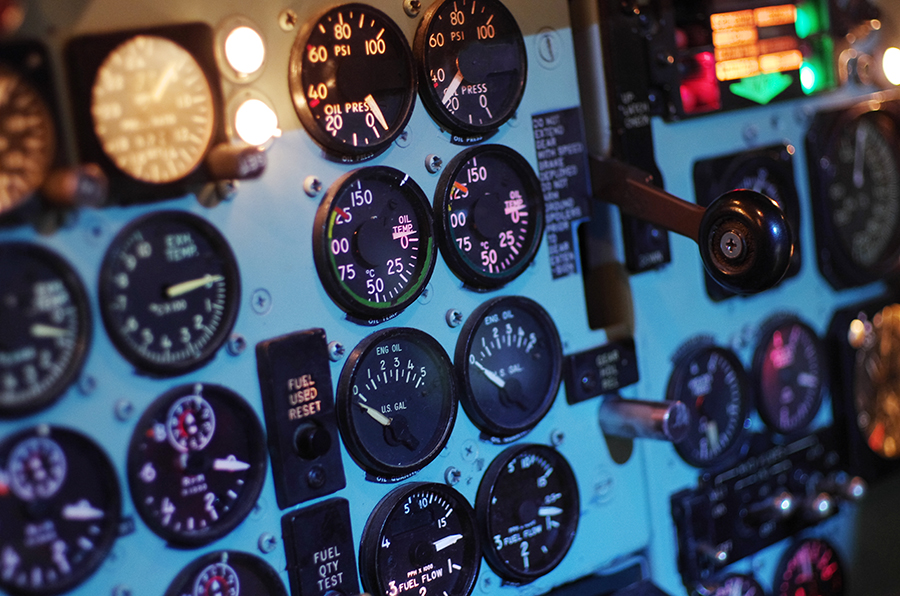-
Components of the Pitot-Static System
-
Operating Principle
-
How Does The System Give Inputs To The ASI?
-
How Does The System Give Inputs To The Altimeter?
-
How Does The System Give Inputs To The VSI?
-
Blockages In The Pitot-Static System
- Blocked Pitot Tube With Clear Drain Hole
- Blocked Pitot Tube And Blocked Drain Hole
- Blocked Static Port And Clear Pitot Tube
-
How Do We Fix Failures In Flight?
- Fixing Pitot Tube Blockages
- Fixing Static Port Blockages
-
How To Prevent Blockages On The Ground?
-
Why Not Have The Pitot Heat On All The Time?
-
Other Sources Of Errors
- Small Errors In The Static Port
- Small Errors In The Pitot Tube
- How Do We Counter The Small Errors?
-
Conclusion
Excuse me, sir, do you know how fast you were going? And how high were you flying?
The answer lies in a small metal tube protruding out into the airstream and a tiny hole in the aircraft fuselage. This seemingly simple setup runs three of the most important instruments in the cockpit. It is called the pitot-static system.
The pitot-static system is used in aircraft to measure the aircraft’s airspeed, altitude, and vertical speed.
The respective instruments for showing these readings are:
- The Airspeed Indicator (ASI)
- The Altimeter
- The Vertical Speed Indicator (VSI)
Components of the Pitot-Static System
Two parts of the pitot-static system are visible from the outside of the aircraft.
One of these is the pitot tube, an L-shaped piece of metal that points forward into the wind. It’s actually a hollow tube with a hole in the front, facing the oncoming air. The pitot tube needs to be installed in a location where it receives unrestricted free airflow.
That means the flow of the air into the instrument shouldn’t be disturbed by any part of the aircraft and should also be clear of the wash created by the propeller.
For this reason, you’ll find one or more pitot tubes mounted on or near the aircraft’s nose. For aircraft that have a propeller mounted on the nose, the pitot tube is placed somewhere it wouldn’t get disturbed air from the propeller.
That’s why in aircraft such as single-engine Cessnas, you’ll find the pitot tube mounted on the leading edge of the wing.
If you look closely, you’ll also notice a very small hole on the backside of the pitot tube. That is a drain hole and it’s used to drain moisture from the inside of the pitot tube.
The other visible part of the system is a small hole in the side of the fuselage that is called the static port. The static port is different from the pitot tube as the hole is positioned flush with the aircraft fuselage and perpendicular to the relative airflow.
The static port also needs undisturbed airflow across the opening in order to get an accurate reading of the atmospheric pressure without the influence of the dynamic pressure caused by the aircraft’s movement.
If you think it would be hard to find undisturbed airflow on the fuselage of a moving aircraft, you’re not wrong! The aircraft manufacturer places the port at a location where airflow is undisturbed for most of the orientations the aircraft is likely to fly in.
The pitot tube and the static port are connected to the instruments using small pressure lines to transmit the pressures. Pressure lines are basically very thin pipes that transmit air pressure from the pitot tube and static port to the instruments.
Of course, an aircraft equipped with a Glass Cockpit instrument panel doesn’t have separate instruments. In that case, the pressure is sent to one or more Air Data Computers (ADCs). This unit is able to convert the pressure into a digital signal that shows the associated reading on the display.
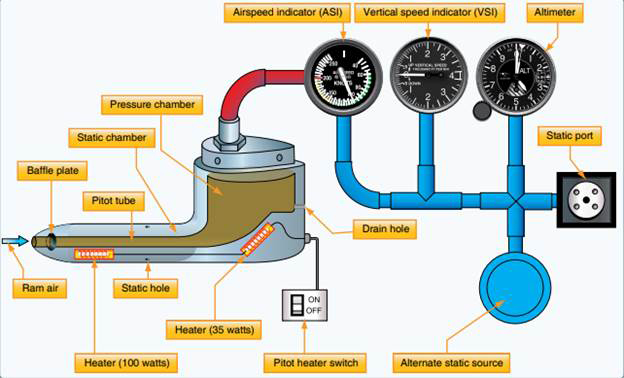
Operating Principle
Bernoulli’s Theorem tells us that the total pressure that the aircraft is experiencing is constant. There are two types of pressures that the aircraft encounters.
One is dynamic pressure, which the aircraft experiences as a consequence of its movement against the air. The faster you fly, the greater the dynamic pressure.
The other component is static pressure, which is caused by the weight of the atmosphere acting on everything. If you fly higher, there’s less of the atmosphere above you, so you’ll experience less static pressure.
The sum of the static pressure and the dynamic pressure is total pressure.
How Does The System Give Inputs To The ASI?
The Airspeed Indicator is the only instrument that relies on inputs from the pitot tube as well as the static port.
As the aircraft is flying through the air, the air exerts pressure back towards the aircraft, acting against the direction of the aircraft’s motion. This pressure is called the dynamic pressure since it only exists as long as the aircraft is moving.
Since the pitot tube is facing the relative wind, it does receive all of the dynamic pressure that the aircraft is experiencing.
However, since the pitot tube is also exposed to the atmosphere, it also experiences static pressure. So the pitot tube measures the total pressure, which complicates matters.
If the static pressure were always constant, it would have been easy to just subtract a constant amount of pressure reading from the pitot tube and present it on the ASI.
But since atmospheric pressure varies with height and local weather, we need to get the precise measurement of the static pressure constantly and keep subtracting it from the total pressure to get accurate airspeed readings at all times.
That’s where we can use the pressure given by the static source. As mentioned earlier, the static source only provides static or atmospheric pressure.
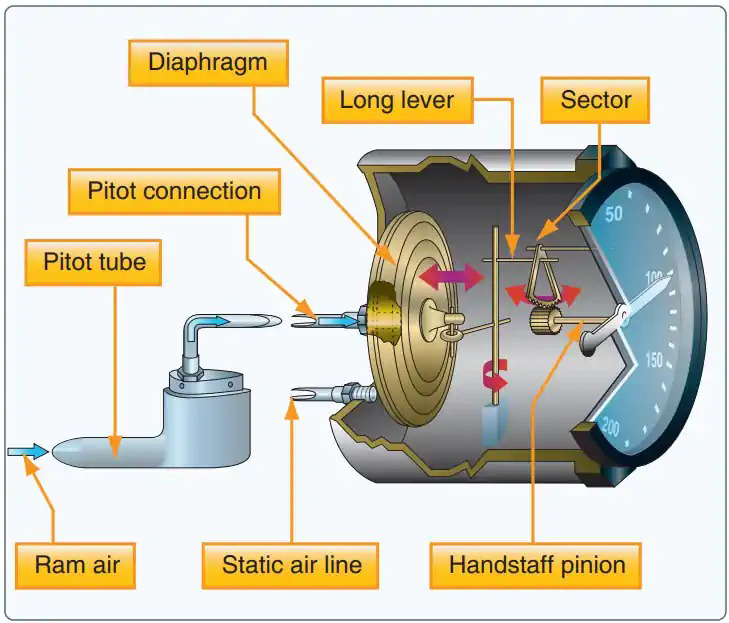
The ASI has two inputs, one from the pitot tube and one from the static port. They are separated by a diaphragm. The static pressure input goes into the airspeed case and the ram air from the pitot tube is sent to the diaphragm.
Since the pitot tube is applying the total pressure against the static port’s static pressure, the resultant pressure on the diaphragm is the dynamic pressure that the aircraft is experiencing.
The diaphragm moves as a result of the pressure differential, and this moves the dial on the ASI via a simple mechanism.
It’s also possible to have a static port and static chamber built into the pitot tube itself as seen in the diagram in the previous section. In this case, the static pressure is subtracted from the total pressure in the tube itself and only the dynamic pressure is sent on to the ASI. This allows you to have a simpler mechanism in the ASI.
By the way, remember that the ASI is only giving you the speed of the airflow relative to the aircraft. Even wind causes dynamic pressure, so you’ll have to correct for the extra dynamic pressure caused by the wind to get your True Airspeed (TAS). You can find out how to do that here.
How Does The System Give Inputs To The Altimeter?
As mentioned earlier, the atmospheric, or static pressure, varies with altitude and weather. The altimeter uses the input from the static port to determine the altitude. The altimeter is the only instrument in small aircraft that gives the pilot altitude information so it’s a critical instrument for the pilot.
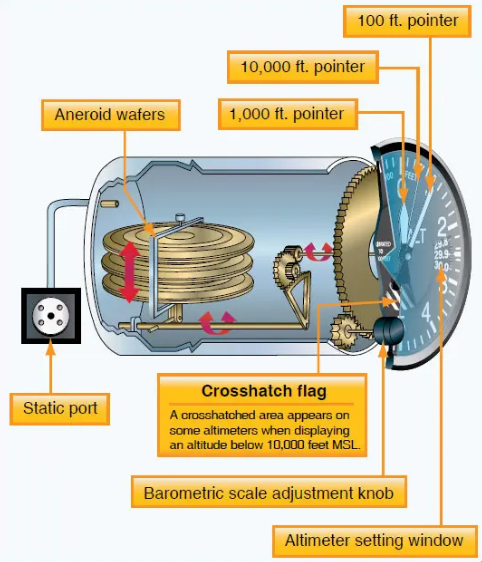
The atmospheric air fills the altimeter’s sealed chamber and acts against a diaphragm similar to the ASI. In the altimeter’s case, however, the diaphragm does not receive any input. It is set by the instrument manufacturer to have a constant pressure of 29.92 inches of Mercury, the standard pressure assumed at sea level in ISA conditions.
As the aircraft climbs, the static pressure decreases. A pressure differential develops between the altimeter chamber and the diaphragm, which causes the diaphragm to move. This movement is translated into the rotation of the pointer needles on the altimeter dial.
You might have noted that the altimeter is going to give readings relative to standard atmospheric pressure by default.
The actual atmospheric pressure changes with high- or low-pressure weather systems. It’s possible to experience a range of atmospheric pressures as you fly along your route, even if you’re flying at a constant altitude.
Altimeters usually have an adjustment knob that you can use to calibrate the instrument according to your local barometric pressure.
There’s a small window in the dial called the Kollsman Window that you can use to see the currently set pressure setting.
If you don’t set the local pressure, you won’t be flying at the altitude you’re supposed to be flying at, which could put you in danger of colliding with other aircraft or high terrain.
The altimeter is also affected by changing temperatures. If you fly into cooler air, your actual altitude will be lower than that shown by the altimeter, and vice versa.
There’s no standard adjustment for temperature, but the pilot should anticipate this phenomenon and try to fly at a higher cruise altitude, especially in mountainous regions.

The chart above is based on formulas used by ICAO. You can use it to give yourself a rough guide of just how much temperature can affect the altimeter reading.
How Does The System Give Inputs To The VSI?
The Vertical Speed Indicator also relies solely on the static pressure input. As the name implies, the VSI shows the rate of the aircraft’s climb or descent. It shows the rate of climb or descent in feet per minute. When you’re flying at a constant altitude, it should indicate zero if it’s been calibrated properly.
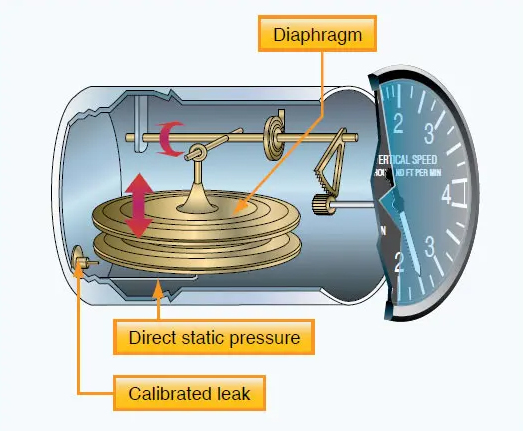
In the VSI’s case, the static pressure enters the instrument through the static pressure line that you can see in the diagram. This line connects to the inside of the diaphragm. The static line also has a restricted hole that leaks pressure at a calibrated rate to the instrument casing.
Both of the inputs are coming from the static port, but the inside of the diaphragm has an unrestricted opening, and the VSI case has a metered opening.
When the aircraft climbs or descends, the static pressure will change instantly in the unrestricted opening, but the case pressure will take longer to adjust because of the restricted opening. This creates differential pressure acting on the diaphragm, which then moves and rotates the connected needle too.
The faster the rate of climb or descent, the greater the differential pressure, and the more the needle will swing.
Blockages In The Pitot-Static System
Since the pitot tube and the static ports are located on the outside of the fuselage, they are exposed to the elements. Their holes can get blocked by ice, dirt, moisture, or even by insect activity!
Both parts of the pitot-static system need clear and unrestricted airflow. When the openings are blocked, the pressure readings they send to the instruments can be wildly incorrect, or might even indicate zero if they are completely blocked.
If you’re flying in Instrument Meteorological Conditions (IMC), you won’t have any outside references. Pilots are trained to trust their instruments since your body is not able to accurately sense the aircraft’s attitude based on feel.
You should know how to diagnose a malfunctioning instrument so that you don’t end up in a mishap. Even experienced pilots have been confused with malfunctioning pitot-static instruments, with fatal results.
In 1996, a Boeing 757 operated by Aeroperu on Flight 603 took off from Lima, Peru with 70 passengers and crew on board. It took off just after midnight on a moonless night and its route took it out over the Pacific Ocean so the pilots had zero outside visual references.
The ground crew had forgotten to take off protective tape from the aircraft’s static ports, and so the pilots had to attempt to fly the 757 while being given contradictory and incorrect instrument readings. Even though they were very experienced pilots, they could not make it back to the airport and crashed into the Pacific.
Three openings in the pitot-static system are important here; the main pitot hole, the static port hole, and the drain hole in the pitot. Blockages in each of them result in distinctive types of errors that the pilot can use to diagnose where the blockage is and how to overcome it.
Blocked Pitot Tube With Clear Drain Hole
In this case, the ram air is unable to enter the pitot pressure line. Since the drain hole is still unblocked, the air that’s already present in the pressure lines and the pitot tube will vent out. The pressure in the system drops down to the current atmospheric pressure.
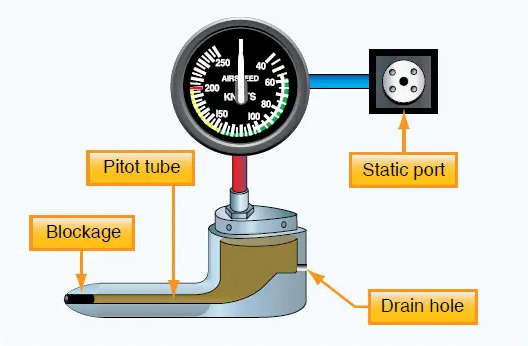
Remember that the ASI is the only instrument dependent on the pitot tube. The airspeed reading will drop down to zero in case of this failure since the pressure inside and outside the diaphragm is equal.
Blocked Pitot Tube And Blocked Drain Hole
If the drain hole is blocked along with the main pitot hole, the pressure that’s already in the system has nowhere to go. If you’re flying at a constant altitude, the ASI will show the same speed even if you accelerate or decelerate.
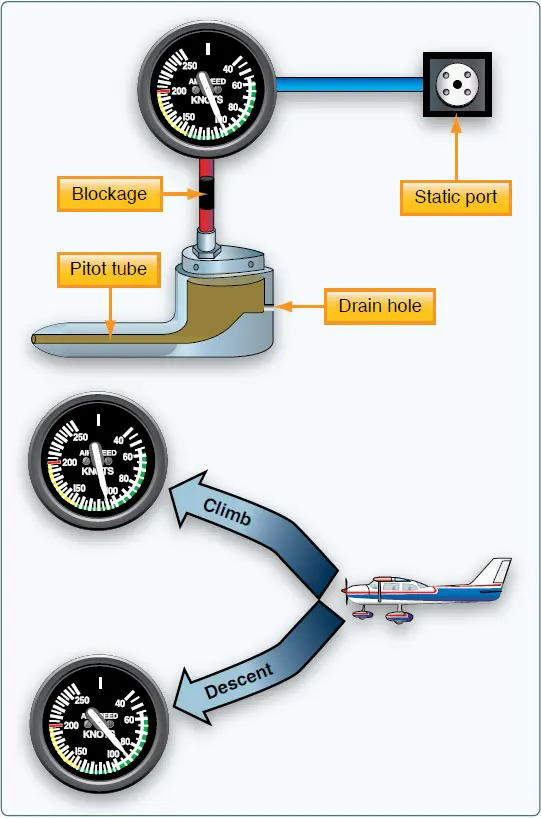
If you climb or descend, however, the difference between the changing static pressure and the constant pressure in the pitot tube will start to show the airspeed changing, albeit inaccurately.
The dynamic pressure is constant, since it is trapped, and the static pressure increases when you descend. The ASI will show your airspeed decreasing when you’re descending, even if you accelerate!
If you’re in a climb, the static pressure will decrease compared to the constant dynamic pressure, and the ASI will show your indicated airspeed increasing, regardless of your actual airspeed.
You can see how this can get dangerous. If the airspeed appears to be increasing past safe levels, the pilot’s instinct is to reduce throttle. But since you’re in a climb, the aircraft might already be flying at a slow airspeed and could stall if the pilot doesn’t realize the error and reduces the throttle.
Blocked Static Port And Clear Pitot Tube
When the static port is blocked, the pressure in the static system has nowhere to vent, so it remains constant. This affects all three instruments. The VSI will always show zero and the altimeter will freeze at the altitude where the blockage occurred.
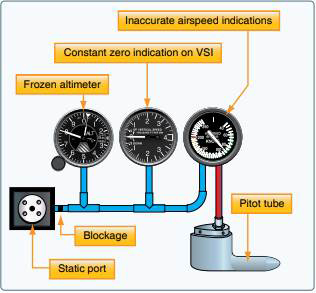
The ASI has an input from the static port as well as from the pitot tube, so it won’t freeze or show zero. You’ll need to be very careful because it’ll look like it’s still working, but it will be giving out inaccurate readings!
Since the static pressure in the ASI casing is trapped, it will only show a valid reading at the altitude where the blockage occurred. The instrument won’t be able to experience a change in the static pressure when the aircraft climbs or descends.
This means that the aircraft’s actual airspeed will be greater than the reading shown on the ASI when the aircraft is flying above the altitude where the blockage occurred.
When flying lower than the altitude where the blockage occurred, the actual airspeed will be less than the reading indicated by the ASI.
The farther the aircraft moves away from the incident altitude, the greater the discrepancy in the ASI readings.
How Do We Fix Failures In Flight?
The most common blockage in-flight occurs due to icing. Icing is most likely to affect the pitot tube since it is mounted outboard facing the airflow. The narrow diameter of the tube is also conducive to ice buildup.
Fixing Pitot Tube Blockages
In case you notice visible moisture in flight, you can use the pitot heat switch to turn on electric heating elements inside the pitot tube. This is a preemptive step that pilots take when they are flying in conditions where icing is likely.
If the pilot doesn’t turn on the pitot heat, ice will build up progressively and will start to affect the instruments as described in the previous section. If the pilot turns on the pitot heat after noticing the malfunctioning instruments, the heaters will take some time to melt the ice buildup inside the pitot tube.
The melted ice should vent from the drain hole. Most pitot tubes have a heater element placed near the drain hole too.
The most well-known example of an aircraft accident involving pitot tube icing is Air France Flight 447. The Airbus A330 began showing erroneous instrument readings when its pitot tubes iced up. The pilots tried to fly the plane based on the incorrect readings and entered a stall that led them down into the Atlantic Ocean.
Fixing Static Port Blockages
It’s rarer for the static port to be blocked by icing. Since it’s flush with the fuselage, the slipstream helps in keeping it clear.
If the pilots determine that the static port is blocked, they can use the alternate static source. Some aircraft are fitted with an alternate static source switch. This switch allows the static system to use the cabin air pressure in place of input from the external static port.
The readings from the alternate static source won’t be as accurate as those from the external port, but it’s better to have a less accurate altimeter than a frozen one.
The aircraft’s Pilot Operating Handbook (POH) or Aircraft Flight Manual (AFM) should have data about the corrections you need to make while the instruments are using the alternate static source.
What do you do if your aircraft doesn’t have an alternate static source feature?
You’ll be surprised to know that the best course of action, in that case, is to break the glass of one of the pitot-static instruments!
Breaking the glass allows the cabin air to enter the static lines, and will make the instruments behave similar to using the alternate static source.
When you break the glass, you’ll probably destroy the instrument. It’s advised to sacrifice the Vertical Speed Indicator if you have to since it’s the least important instrument of the three.
How To Prevent Blockages On The Ground?
When it’s parked on the tarmac, the aircraft faces other threats to the pitot-static system.
Chances of blockages by dirt and dust particles increase if the aircraft is parked in a windy environment for an extended period of time.

Small holes are also very inviting to insects, which might even try to build nests inside!
Here’s some perspective of how serious this is: The likely cause of the crash of Birgenair Flight 301, a Boeing 757 carrying 189 people, was a wasp nest built inside the pitot tube. The aircraft had spent at least two days parked with the pitot tubes uncovered, which was enough time for the wasps to block one of the pitot tubes.
In order to avoid similar incidents, pilots or ground crew cover the pitot tubes with a brightly colored cover that is labeled ‘Remove Before Flight’.
The pitot cover is one of the items that is checked at every preflight aircraft walkaround by the flight crew. If you forget to remove the pitot cover before departure, you won’t have any airspeed information with no way to get it back until you land.
The consequences for leaving the static port blocked before departure is more severe since the static port provides input to all three pitot-static instruments as compared to the pitot tube’s sole input to the ASI.
The previously mentioned Aeroperu incident is a good reminder for you to check the static ports on your walkaround as well.
Why Not Have The Pitot Heat On All The Time?
When you’re in flight, not only is the surrounding air colder, but the heat also leaves the pitot tube by convection from the oncoming air.
There’s not a lot of heat loss from convection when you’re standing still on the ground, so the heat will continue to accumulate if the pitot heat is still on. The tube can heat up to several hundred degrees if you turn it on for an extended period of time while you’re on the ground!
Remember that you need to put the pitot cover on the tube when you’re securing the aircraft after the flight. If the pitot tube is still hot, it could burn your hand or even melt the cover!
There are also two secondary reasons not to leave the pitot heat on all the time.
One reason is to prevent the heating elements from wearing out early.
The other reason is to reduce the load on the aircraft’s electrical system.
Large commercial aircraft have ample electrical power available, but small general aviation aircraft are only equipped with one small battery. The battery is used to power some instruments, aircraft lights, radios, and other equipment including the pitot heat.
The battery is being continuously charged while the engine is running, but In case of engine failure, the amount of time that the battery can last depends on the aircraft’s power draw.
Leaving the pitot heat on can rob you of precious battery power when you need it. That’s why it’s best to only use it when flying into known icing conditions.
Other Sources Of Errors
The pitot-static system also encounters errors that are less drastic but still fairly significant. A small amount of error is acceptable for normal flight operations and it’s not practical to completely remove it.
Small Errors In The Static Port
The static port is vulnerable to position error. Aircraft manufacturers try to place the static port in a position on the fuselage where it’s able to measure the atmospheric pressure without any influence from the aircraft’s movement.
In reality, it’s not possible to have zero position error at all angles of attack the aircraft experiences, but the static port is placed in a location where the error is as low as possible.
Small Errors In The Pitot Tube
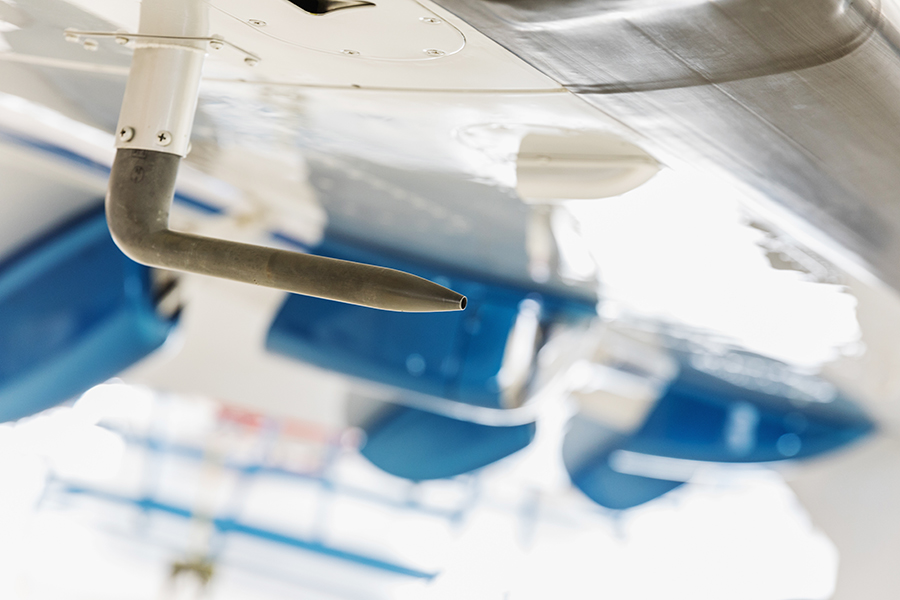
The pitot tube doesn’t experience position error. It’s measuring total or stagnation pressure, which is equal at all points on a streamline. The pitot tube does, however, experience alignment error.
When the aircraft is not flying straight and level, such as flying in a bank, in a sideslip, or with a significant nose up or down attitude, the pitot-static system is not receiving all of the airflows the aircraft is experiencing.
Some of the airflows can be blocked by the fuselage itself, or because of the opening not being perpendicular to the relative wind due to the aircraft’s orientation.
A reduced airflow results in reduced dynamic pressure, which means that the ASI won’t be showing the actual speed of the aircraft through the air. This error is called an alignment error.
The pitot tube should provide accurate readings up until the relative wind is angled around 15 degrees to the pitot tube. Such a large angle only happens at extreme Angles of Attack, such as when the aircraft is about to stall.
Since the ASI is likely to be inaccurate at that angle, you should rely on the stall warning horn instead of the airspeed shown on the ASI to figure out if the aircraft is about to stall.
How Do We Counter The Small Errors?
The small errors in the pitot-static system are countered by using multiple pitot tubes and static ports on both sides of the aircraft fuselage.
When the aircraft is in a bank or is affected by wind from one side, the pressure readings on either side of the fuselage will differ.
Using pitot-static systems with inputs from both sides feeding into a common pressure line reduces the smaller errors considerably.
Larger aircraft often have multiple pitot-static systems that are independent of each other. Airliners commonly use a separate system for the captain’s instruments, another for the First Officer’s instruments, and in some cases a third pitot-static system for standby instruments. Separate and independent systems provide redundancy, which is good to have for instruments as important to flight as these.
During the takeoff run, the Pilot Not Flying (PNF) keeps an eye on the airspeed indicator and calls out an airspeed, usually 80 knots. The Pilot Flying (PF) looks at their own ASI and verifies that it is also reading the same airspeed.
Your general aviation aircraft might only have one airspeed indicator and one pitot-static system, but it’s still a good idea to call out your airspeed during your takeoff run. This lets you know that your pitot tube isn’t blocked and that you haven’t forgotten to take the pitot cover off!
Conclusion
The Airspeed Indicator, the Altimeter, and the Vertical Speed Indicator are three of the six basic flight instruments. Even though the system that provides them inputs operates using just air pressure, diagnosing and fixing errors in the system can be tricky. Knowing how the system works, and more importantly, how it fails, helps you be more prepared for your next flight.
